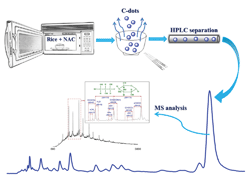Green synthesis of fluorescent nitrogen/sulfur-doped carbon dots and investigation of their properties by HPLC coupled with mass spectrometry†
Abstract
A fast and green approach to synthesise ultrasmall nitrogen (N) and sulfur (S)-doped carbon dots (N,S-C-dots) by microwave-assisted pyrolysis of the precursors rice as carbon source and N-acetyl-L-cysteine (NAC) as N and S dopant has been developed. The obtained N,S-C-dots were fully characterised by elemental analysis, Fourier transform infrared spectroscopy, X-ray photoelectron spectroscopy, transmission electron microscopy, UV-vis absorption and photoluminescence (PL) spectroscopy. The undoped C-dots (derived from rice only) and N,S-C-dots possess different chemical compositions, sizes and spectral properties. With the assistance of high-performance liquid chromatography coupled with fluorescence detection (HPLC-FD), the effect of different mass ratios of NAC to rice (NAC/rice) on N,S-C-dots was investigated. Higher NAC/rice ratio benefits the generation of N,S-C-dots with stronger fluorescence emission. In addition, the HPLC separated N,S-C-dots fractions were collected and further characterised by mass spectrometry, UV-vis absorption and PL spectroscopy, showing that the structural changes induced by doping with heteroatoms N and S plays a key role in regulating the PL properties of the N,S-C-dots. This work highlights the merits of synthesising N,S-C-dots from readily available natural bioresources and applying modern HPLC-FD technology to study the effect of doped heteroatoms on N,S-C-dots properties.


 Please wait while we load your content...
Please wait while we load your content...